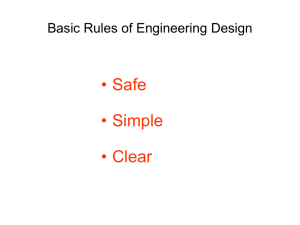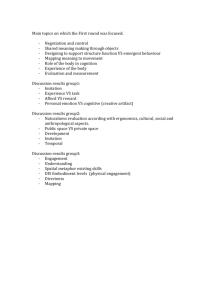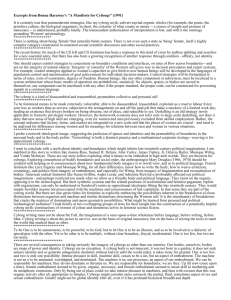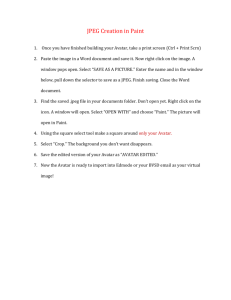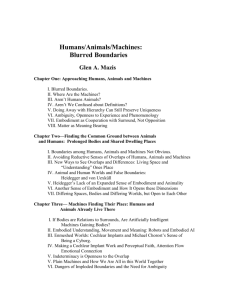as a body
advertisement
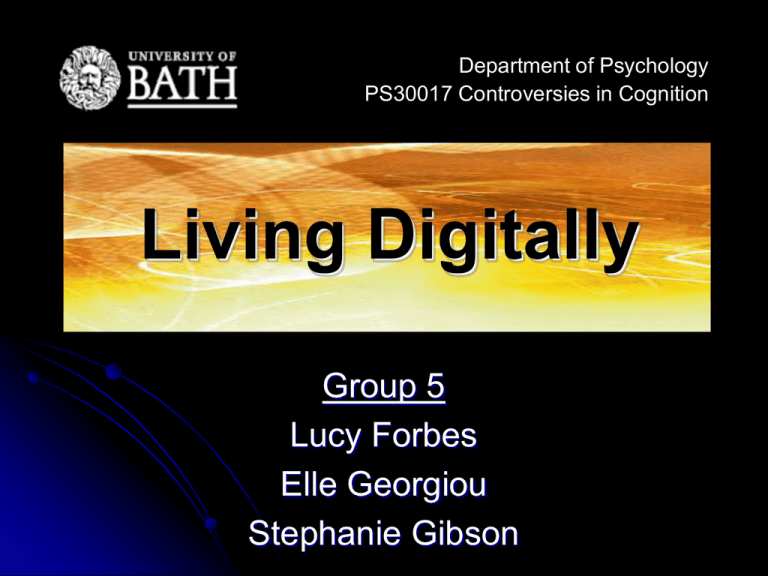
Department of Psychology PS30017 Controversies in Cognition Living Digitally Group 5 Lucy Forbes Elle Georgiou Stephanie Gibson Presentation Outline 1. The Mind-Body Controversy 2. Embodiment and Presence 3. The Contemporary Controversy 4. Case Study (Living Digitally) 5. Progressive Embodiment 6. The Cyborg Dilemma 7. Discussion The Mind and the Body An age-old philosophical and psychological controversy What is real? How can we know it? Can we ever know it? (Lakoff & Johnson, 1999) Dualism The dualistic view of the mind-body relationship emphasises: Mind and body must be separate Superiority of the mind over the body Reality is the interpretation of the mind only Descartes (1596-1650) argued that the mind has no biological reality and therefore can not be studied using scientific methods Holism In opposition to dualism, the holistic view of the mind-body relationship emphasises: The fused unity of the body and mind The dynamic, ongoing life of unified, whole people Embodiment Embodiment Can refer to the things we consciously notice about the role of our bodies in shaping our self-identity and our sense of reality (Brandt, in Rohrer, 2003) The bodily aspects of human subjectivity Gives concrete form to an abstract concept Used as a counter-Cartesian philosophical account of the mind Merleau-Ponty (1902-1961) suggested that man is characterised as an embodied consciousness (Hartman, 2005) Physiological vs. Phenomenological Body Embodiment enables us to distinguish between: An objective body i.e. a physiological entity and A phenomenological body i.e. some physiological body but as we experience it “Embodiment is not a concept that pertains to the body grasped as a physiological entity. Rather, it pertains to the phenomenal body and to the role it plays in our object directed experiences.” (Cambridge Dictionary of Philosophy, 1999, pg. 258) Presence Presence and immersion in virtual environments (VE) illustrates how embodiment helps us to make sense of what is ‘real’ Presence is “the subjective sense of being in the virtual place.” The presence phenomenon psychological research in VEs Psychology “determines what is and what is not virtually ‘real’” is central to (Schubert et al., 1999) Embodied Presence in VEs “User embodiment is concerned with the provision of users with a representation of their choice so as to make others (and themselves) aware of their presence in a virtual space” Mania and Chalmer (2004) What can embodiment tell us about how we construct virtual environments as our reality? Can this be extended to explain our experiences of sense of self and reality? Can virtual environments provide a contemporary means to explore the mind-body controversy? The Contemporary Controversy So if we exist consciously as a body, does it need to be our objective, physiological body? Virtual environments provide evidence that we are able to develop a sense of our selves outside of the physical body What does this contribute to the mind-body debate? And what implications does this have for the future? Case Study Living Digitally: Embodiment in Virtual Worlds (Taylor, 2002) Ethnographic study examining how digital bodies facilitate life in a virtual world The : graphical and text-based multi-user system, 2 1/2D world, thirdperson perspective, real time Avatars in The Dreamscape An embodiment, as of a quality or concept, an archetype The American Heritage Dictionary of the English Language An image representing a user in a multi-user virtual world The Free On-line Dictionary of Computing The material out of which relationships and interactions are embodied Taylor (2002) Living in The Dreamscape Living in The Dreamscape Living in The Dreamscape 1. Social Life Users do not simply roam through the space as “mind” but find themselves grounded in the practice of the body, and thus in the world It is through a performance of the body, in this case via the avatar, that one’s ‘self’ is rooted in the VE - communication of collective sentiments Avatar bodies don’t exist in isolation, they exist in context - personal boundaries (Becker & Mark, 1999) It is through the use of the body as material in the dynamic performance of identity and social life that users come to be “made real”, not only to the user themselves but to others around them - embodied social practice Living in The Dreamscape 1. Social Life Users do not simply roam through the space as “mind” but find themselves grounded in the practice of the body, and thus in the world It is through a performance of the body, in this case via the avatar, that one’s ‘self’ is rooted in the VE - communication of collective sentiments Avatar bodies don’t exist in isolation, they exist in context - personal boundaries (Becker & Mark, 1999) It is through the use of the body as material in the dynamic performance of identity and social life that users come to be “made real”, not only to the user themselves but to others around them - embodied social practice Living in The Dreamscape 1. Social Life Users do not simply roam through the space as “mind” but find themselves grounded in the practice of the body, and thus in the world It is through a performance of the body, in this case via the avatar, that one’s ‘self’ is rooted in the VE - communication of collective sentiments Avatar bodies don’t exist in isolation, they exist in context - personal boundaries (Becker & Mark, 1999) It is through the use of the body as material in the dynamic performance of identity and social life that users come to be “made real”, not only to the user themselves but to others around them - embodied social practice 2. Personal Identity Avatars can foster different associations and forms of self They reflect the inner self and the social world Users can identify their avatars as “more them” than their corporeal body You not only project yourself into your digital body, but you are actually made most real, most true via it Avatars provide the opportunity to see your ‘self’ as others see you; a “better” version of self 3. Bodies With Limits Living digitally raises questions about what our bodies are, who we are, and what we can be digitally Although embodiment helps foster identities and social lives, avatars can also limit and constrain progressive possibilities The Dreamscape operates within a specific gender dichotomy which shapes the possibilities for identity Current graphical representations of the body are limited Case Study Summary Avatars are the central artifacts through which people build their social lives and identities in a virtual world The avatar as a body is woven into the structure of life in these worlds This provides evidence for the role of ‘body’ as a representation of the mind Addressing the Controversy So if we exist consciously as a body, does it need to be our objective, physiological body? What does this contribute to the mind-body debate? What implications does this have for the future? Progressive Embodiment “How does the changing representation of the body in virtual environments affect the mind?” (Biocca, 1997) Progressive embodiment, as a result of technological developments, may lead to the individual becoming unnatural, a cyborg The interface of the physical body with technology The Cyborg Dilemma “The more natural the interface the more “human” it is, the more it adapts to the human body and mind. The more the interface adapts to the human body and mind, the more the body and mind adapt to the non-human interface. Therefore, the more natural the interface, the more we become “unnatural”, the more we become cyborgs.” Biocca (1997) The Cyborg Dilemma “The more natural the interface the more “human” it is, the more it adapts to the human body and mind. The more the interface adapts to the human body and mind, the more the body and mind adapt to the non-human interface. Therefore, the more natural the interface, the more we become “unnatural”, the more we become cyborgs.” Biocca (1997) “You are already a cyborg. Everyday, without thinking, you merge with machines and machines merge with you. Climb into your car and you conjoin with a ton of moving metal; between you and the road, the vehicle is perfectly responsive, an extension of your nerve and nerves, adjusting it’s grip on the asphalt as you turn the wheel. Log on to the Net and your body vanishes from the metaspace of your study and pops up in a wider world. We are cyborgs when we receive a titanium heart valve, get a MRI scan, breathe climatecontrolled air, eat processed food, or fall asleep in front of the TV and hear the language of infomercials in our dreams…” The Cyborg Manifesto (2005) “It’s life Jim, but not as we know it…” - Spock References Biocca, F. (1997). The Cyborg’s Dilemma: Progressive Embodiment in Virtual Environments. Journal of Computer Mediated Communication 3(2). Becker, B., & Marl, G., (1999). Constructing Social Systems Through Computer-Mediated Communication. Virtual Reality, 4:60-73. Cambridge Dictionary of Philosophy (2nd ed.) (1999) ‘Embodiment’, pg. 258. Dictionary of Philosophy of Mind [online]. Available: http://www.artsci.wustl.edu/~philos/MindDict/ [Accessed April 2005]. Hartman, G. (2005). Maurice Merleau-Ponty [online]. Available: http://jmchar.people.wm.edu/Kin493/kinst08c.html [Accessed April 2005]. Lakoff, G. & Johnson, M. (1999). Philosophy in the Flesh: The Embodied Mind and its Challenge to Western Thought. New York: Basic Books. References Mania, K., & Chalmers, A., (1998) A Classification for User Embodiment in Collaborative Virtual Environments In: Proc. of the 4th International Conference on Virtual Systems and Multimedia, pgs. 177-182. IOS Press: Ohmsha, Ltd. Rohrer, T., (2003) Embodiment and Experientialism. In Geeraerts, D., & Cuyckens, H., (eds.) The Handbook of Cognitive Linguistics. Oxford: University Press. Schubert, T., Friedmann, F. & Regenbrecht, H. (1999). Embodied Presence in Virtual Environments [online]. Available: http://www.personal.uni-jena.de/~sth/papers/vri98.pdf [Accessed March 2005] Taylor, T.L. (2002). Living Digitally: Embodiment in Virtual Worlds. In Schroeder, R. (ed.) The Social Life of Avatars: Presence and Interaction in Shared Virtual Environments. London: Springer-Verlag. References The American Heritage Dictionary of the English Language. ‘Avatar’ [online]. Available: http://www.bartleby.com/cgibin/texis/webinator/ahdsearch?search_type=enty& uery=avatar&db=ahd [Accessed April 2005]. The Cyborg Manifesto [online]. Available: www.cyborgmanifesto.org [Accessed March 2005]. The Free Online Dictionary of Computing. ‘Avatar’ [online]. Available: http://wombat.doc.ic.ac.uk/foldoc/foldoc.cgi?query=avatar&action=Search [Accessed April 2005]. Department of Psychology PS30017 Controversies in Cognition Living Digitally Group 5 Lucy Forbes Elle Georgiou Stephanie Gibson
